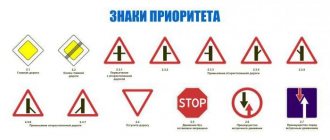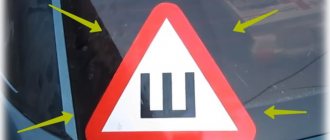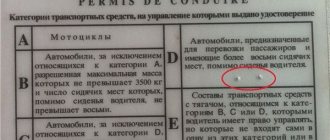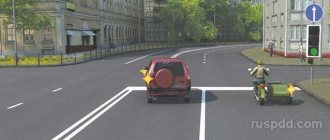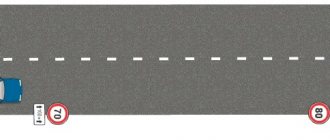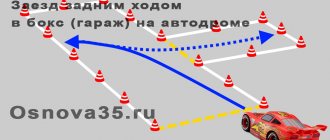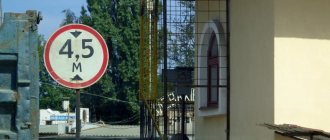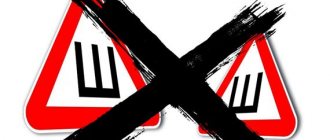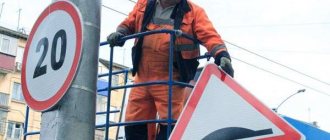Description
Like most warning signs, 1.13 and 1.14 are designed in the form of a triangle with a red edge. These signs are designed to attract the attention of drivers with bright colors and warn of possible danger. On road signs indicating a descent or ascent, the slope of the road with percentages is symbolically depicted.
The slope is calculated as the ratio of the height of the climb and the distance traveled, based on a 100-meter segment of the path. Indicated as a simple fraction or as a percentage in geodesy; On road signs, the steepness of slopes and inclines is indicated only as a percentage.
Example: in front of us is a sign “Steep climb” indicating 12%. If we have this opportunity and look at the road from the side, we will see that the angle of inclination in this place is approximately 12 degrees relative to the horizon. If you travel a distance of one kilometer on a road with a 12% slope, you will rise or descend 120 meters.
In accordance with the prescription of paragraph 11.4 of the set of traffic rules, it is strictly forbidden to overtake at the end of the climb.
When detouring on an uphill slope, you:
| 1. | You have the right to pass first. |
| 2. | Must give way. |
The “Steep Ascent” sign warns you that you are entering an incline. Since in this situation oncoming traffic is difficult, the driver of the oncoming car must give way as he is moving downhill.
Explanation
Often drivers do not immediately understand which sign is in front of them: a steep descent or an ascent. Especially if the slope is small or it is snowing and visibility is difficult.
To quickly navigate the situation, use the following simple tips:
1The principle of reading road signs is no different from reading text, that is, from left to right. By moving your eyes from left to right, you can easily understand whether this road sign means up or down.
2Using the palm of your left hand, visually repeat the slope of the road shown on the sign. If the fingers point down, this means that there is a steep descent ahead, but if on the contrary, we are going uphill.
The sign of ascent and descent - we learn to distinguish between them and understand the meaning of percentages on them
Good afternoon dear friends. We continue to study the rules of the road or refresh them in our memory; you must agree, this also needs to be done periodically. Last time we sorted out the traffic controller’s gestures, today it’s time for road signs. Today we will learn to understand and distinguish between the signs of ascent and descent , and find out what the percentages on them mean.
What the traffic rules tell us
The descent sign is indicated in the rules by number 1.13 - it means that there will be a descent from the mountain ahead. The percentages on a white background indicate the degree of steepness of the descent. The driver should be prepared. It is installed directly at the beginning of the dangerous area.
GOST installation of other warning signs at a distance of 150-300 meters does not apply to it; it is placed directly in front of the site. Because it may be immediately followed by a rise, this distance cannot be maintained. If there are many such sections on the road, then there is no point in following the rules for its installation.
The ascent sign in the traffic rules is indicated by the number 1.14. It means that there is a mountain climb ahead of the driver; its angle of inclination is also indicated by percentages on a white background. This sign, as well as its neighbor, the descent sign, is subject to the same installation requirements.
If the road runs through a mountainous area where descents and ascents alternate, then only one sign is placed separating the flat section of the road with a steep descent or ascent. If such sections follow each other, without an even section of the path, then they are not installed between them. You need to be prepared for this.
How to distinguish the sign of ascent and descent, how easy it is to remember
There is an unspoken rule about the left hand and the direction of the fingers to distinguish these signs from each other. But I came up with a simpler method that I want to share with you.
For example, a rising sign. Since we read and write from left to right, we put a fictional person or a dot in the left corner. We move our eyes from left to right this point. If it rises up, then this is a sign of “rise”.
If you set a dot in the left corner and move it with your eyes in the direction of reading. If the point begins to descend from top to bottom, then this is a sign of a “steep descent”.
I find this much easier than sticking out your left hand while driving and looking at the direction of your fingers. To compare these two methods, let’s tell you about it.
We're driving and there's a sign ahead. We stretch out our left hand, take our eyes off the steering wheel, and take our eyes off the road. Place the palm of your hand in the direction of the inclined line dividing the white background from the black, fingers extended and folded together. If the fingers point downwards, it is a steep descent, if upwards, it is an ascent.
Agree, it is inconvenient and sometimes dangerous when such sections often alternate with smooth sections of the road. You constantly need to be distracted from driving, you can get confused.
I recommend trying out in practice these two methods of distinguishing steep descent and ascent signs. Choose for yourself the best option on how to distinguish them from each other.
What do percentages mean on a white background?
It took me a long time to get my head around, if the numbers on the signs mean the angle of inclination of the road surface, then why isn’t it indicated in degrees? It would be more familiar to everyone.
The fact is that the slope may not be the same throughout the entire descent or ascent from the mountain. It is not possible to write a definite degree; it may differ.
Let’s say that on the first segment of 10 meters it is 5 degrees, on the second segment of 20 meters it will be 15 degrees, so what angle of inclination in degrees should be indicated on the sign?
To avoid confusion, we decided to indicate the curvature of the road slope as a percentage. They mean that for every 100 meters of road traveled, after the start of a dangerous section, you will rise or fall by 12 meters, if the steep descent or ascent sign indicates 12 percent.
That is, if you see a “steep climb” sign ahead with the numbers 12%, this means that after the start of the dangerous section indicated by this sign, you will travel a distance of 1 kilometer, then you will rise 120 meters higher, relative to the starting point.
Who has the advantage?
Now let's talk about who is more important - the one who goes down the mountain or the one who goes up the mountain. The traffic rules state:
The right of way has the right of way for the road user who goes down. That is, those who have a dangerous area marked with a “steep descent” sign.
This rule applies only to those sections of the road where signs 1.13 and 1.14 are installed. If there are none, then the drivers let each other through by mutual agreement. In some places, traffic priority may be set by signs 2.6 and 2.7, but that's another story.
Source: https://avtoyoutubb.ru/znak-podema-i-spuska-chto-znachat.php
Coverage area
Important!
The main task of a group of warning signs is to signal possible unforeseen situations that may arise along a given section of the route. Therefore, it is logical to place them at some distance from the dangerous area so that the driver can concentrate and think through his further actions.
Based on this, signs 1.13 and 1.14, like most others, are placed 50-100 meters before the start of a steep descent or ascent within populated areas and 150-300 meters outside the city.
Road signs can be combined with information plates:
- 8.1.1 indicating how many meters are left to the dangerous section of the road;
- 8.2.1 with information about how many meters the dangerous section of the roadway will last.
In a situation where, after a steep descent, the road immediately begins to rise, sign 1.14 will be placed directly at the very beginning of the ascent.
Road sign requirement 1.13
Sign 1.13 steep descent makes it clear to the driver that on a descent the car can behave differently, namely roll spontaneously.
Therefore, the driver must be vigilant and control the speed limit, since on a descent the braking distance will be increased.
On any slope, the car can roll if the driver does not use the parking brake or gearbox to park the car.
It will be important to use engine braking when driving down a steep slope, this will reduce the effort on the brake discs and the process of their wear.
It should be borne in mind that if there is a malfunction in the brake system, the situation on a steep descent can be catastrophic. Therefore, you need to choose the lowest possible gear and low speed, or if it is possible to bypass this section of the road.
In icy conditions, you should not take risks at all if you are not confident in the road grip of winter tires and the performance of the braking system, since it will not be possible to stop the car on a steep descent.
Comments
If vehicles pass in places where signs 1.13 and 1.14 are in effect, it is worth remembering that the one moving uphill has priority in traffic. This rule is regulated by paragraph 11.7 of the traffic rules.
Imagine the situation: you are a car driver and you are driving down a steep slope. There is an obstacle in the form of a landslide ahead, which completely blocks the path of an oncoming car moving uphill. The favorable outcome of this situation depends on your competent actions. According to the interpretation of clause 11.7 of the traffic rules, you must give priority right of passage to a car that is moving uphill, despite the fact that the obstacle is located in its lane.
This advantage was established due to the fact that stopping on an ascent and then moving up a hill is much more difficult than performing the same actions when descending: the car may roll back or stop the engine.
An obstacle is a stationary obstacle that has arisen on the way and impedes further movement along a given lane of the roadway. This could be a faulty vehicle, road damage, foreign objects, and much more. The traffic jam is not an obstacle.
If it is difficult to pass oncoming traffic on such a section of the road, the following has the advantage:
| 1. | Truck driver. |
| 2. | Driver of a car. |
The “Steep ascent” sign warns the driver of a passenger car that they are approaching an incline. If it is difficult to pass oncoming traffic on this section of the road, the driver of a passenger car has the advantage, since he is moving uphill.
Fines
Failure to comply with the requirements of road signs entails an administrative penalty. A detailed table of fines and explanations can be found on the traffic police website.
12.15 Part 1 Violation of the rules of oncoming traffic will entail the imposition of an administrative fine in the amount of 500 rubles.
12.15 Part 1 Incorrect positioning of a vehicle on the roadway or oncoming traffic lanes entails a fine of 1,500 rubles.
12.14 Part 3 Failure to comply with traffic rules and ignoring the rule to give way to a vehicle enjoying the right of priority, except for the cases provided for in Part 2 of Article 12.13 and Article 12.17 of the current rules - a warning or a fine of 500 rubles.
Liability for violation of sign 1.13
As such, there is no punishment for violating sign 1.13. However, the descent represents a difficult section of the road for drivers in both directions. Accordingly, if there is a detour ahead of the descent, the driver moving in the oncoming lane has priority in passing.
For violating the right-of-way by another driver, the violator may be fined 500 rubles, or issued a written warning under Part 3 of Art. 12.14 Code of Administrative Offenses of the Russian Federation.
Also, on the downhill section, due to driver inattention or poor visibility of road markings, the driver may find himself in the oncoming lane.
In this case, liability arises in the form of a fine of 1000-1500 rubles under Part 3 of Art. 12.16 of the Code of Administrative Offenses of the Russian Federation or 5,000 rubles, or deprivation of rights for 4-6 months under Part 4 of Art. 12.16 Code of Administrative Offenses of the Russian Federation.
